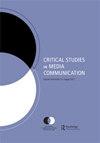The politics of Digital India: between local compulsions and transnational pressures
IF 1.5
2区 文学
Q3 COMMUNICATION
引用次数: 1
Abstract
horse and next to a Bugatti automobile, the trappings of European civility. Despite Brown’s efforts to assimilate, the French continued to view him through a racialized lens. Chapter four is an analysis of the work of Uruguayan painter Pedro Figari, who was born to Italian parents. Figari centered Blackness in his visions of the cultural mixing that characterized the “Americas,” a locale he conceived of as beyond national boundaries (p. 142). Using an anthropological lens, Figari essentialized the cultural contributions of Black Uruguayans and Argentines as “candombe,” a West and Central African dance tradition syncretized with Catholicism. While Figari’s impressionistic paintings of African dancers reinforced notions of their primitivism, he also argued for Black intelligence and blamed whites for creating white supremacist, segregated societies. Williams notes the contradictions in Figari’s work: his writings cast African-descended people as “hypersexual and uncultivated animals,” but his paintings also humanized his subjects (p. 174). Williams concludes that through these oscillating portrayals, Figari created new stereotypes that were tied to his cultural context, consigning Black Latin Americans to “a visible but isolated existence” (p. 180). Williams’s book is particularly relevant to international media critics and art historians who seek to understand the Latin and African diasporas across the colonial world. In the concluding chapter, Williams articulates her theory of Latinizing Blackness, which distills the impact of the complex politics of racial identity during this era. Williams could reference this theory throughout the book to more clearly guide her analysis of Latin American and Black identities in Parisian representations. Similarly, Williams presents notions such as the “gaze” that Parisians used upon Latin Americans and that Latin Americans sometimes returned. Future research could expand upon this notion according to gendered and racialized understandings of the colonial gaze and the technology of white sight, as articulated by Nicolas Mirzoeff. Finally, the often-convoluted terms translated from Spanish, French, and other languages, particularly the racial epithets used for Black Latin Americans, could further contextualized historically. A discussion of not only their denotations but also their connotations and larger social implications would round out Williams’s analysis. In sum, Williams’s survey of representations of Latin Blackness begins to expose the complex processes of Europeans’ racialization of African descendants in transnational and transcolonial contexts, which resulted in ambivalent, and contested, representations.数字印度的政治:在地方强制和跨国压力之间
旁边是一辆布加迪汽车,这是欧洲文明的标志。尽管布朗努力融入法国,但法国人继续用种族化的眼光看待他。第四章是对乌拉圭画家佩德罗·费加里作品的分析,他的父母是意大利人。费加里把黑人作为他对“美洲”文化融合的看法的中心,他认为这是一个超越国界的地方(第142页)。费加里用人类学的视角,将乌拉圭黑人和阿根廷黑人的文化贡献概括为“candombe”,这是一种与天主教融合在一起的西非和中非舞蹈传统。虽然费加里的非洲舞者的印象派绘画强化了他们的原始主义观念,但他也为黑人的智慧辩护,并指责白人创造了白人至上主义和种族隔离的社会。威廉姆斯注意到费加里作品中的矛盾:他的作品把非洲人后裔描绘成“性欲亢进和未开垦的动物”,但他的绘画也使他的主题人性化(第174页)。威廉姆斯的结论是,通过这些摇摆不定的描绘,费加里创造了与他的文化背景相关的新刻板印象,将拉丁美洲黑人视为“可见但孤立的存在”(第180页)。威廉姆斯的书对那些试图了解拉丁和非洲移民在殖民世界的国际媒体评论家和艺术史学家特别有意义。在最后一章,威廉姆斯阐述了她的拉丁化黑人理论,提炼了这个时代复杂的种族身份政治的影响。威廉姆斯可以在整本书中引用这一理论,以更清晰地指导她对巴黎表现中的拉丁美洲和黑人身份的分析。同样,威廉姆斯也提出了一些概念,比如巴黎人对拉丁美洲人的“凝视”,而拉丁美洲人有时也会回敬他们。正如Nicolas Mirzoeff所阐述的那样,未来的研究可以根据对殖民凝视和白人视觉技术的性别和种族化理解来扩展这一概念。最后,从西班牙语、法语和其他语言翻译过来的经常令人费解的术语,特别是用于拉丁美洲黑人的种族绰号,可以进一步在历史背景下化。对其外延、内涵和更大的社会影响的讨论将使威廉姆斯的分析更加完善。总而言之,威廉姆斯对拉丁黑人表征的调查开始揭示欧洲人在跨国和跨殖民背景下对非洲后裔的种族化的复杂过程,这导致了矛盾和有争议的表征。
本文章由计算机程序翻译,如有差异,请以英文原文为准。
求助全文
约1分钟内获得全文
求助全文
来源期刊

Critical Studies in Media Communication
COMMUNICATION-
CiteScore
2.10
自引率
0.00%
发文量
34
期刊介绍:
Critical Studies in Media Communication (CSMC) is a peer-reviewed publication of the National Communication Association. CSMC publishes original scholarship in mediated and mass communication from a cultural studies and/or critical perspective. It particularly welcomes submissions that enrich debates among various critical traditions, methodological and analytical approaches, and theoretical standpoints. CSMC takes an inclusive view of media and welcomes scholarship on topics such as • media audiences • representations • institutions • digital technologies • social media • gaming • professional practices and ethics • production studies • media history • political economy. CSMC publishes scholarship about media audiences, representations, institutions, technologies, and professional practices. It includes work in history, political economy, critical philosophy, race and feminist theorizing, rhetorical and media criticism, and literary theory. It takes an inclusive view of media, including newspapers, magazines and other forms of print, cable, radio, television, film, and new media technologies such as the Internet.
 求助内容:
求助内容: 应助结果提醒方式:
应助结果提醒方式:


